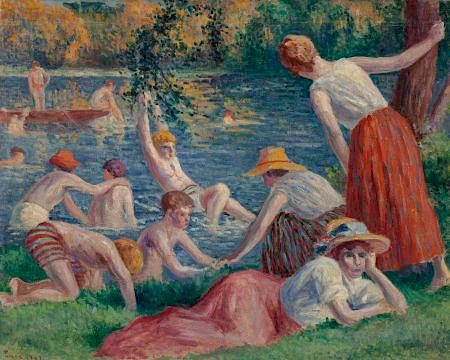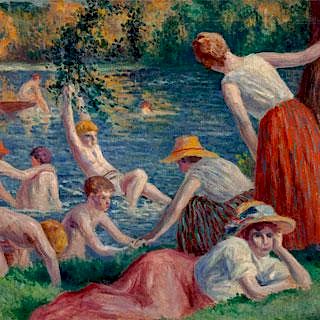Maximilien Luce (French, 1858-1941) Baignade dans la Cure, 1909 Oil on can
Lot 66023
Categories
Estimate:
$50,000 - $70,000
Absentee vs Live bid
Two ways to bid:
- Leave a max absentee bid and the platform will bid on your behalf up to your maximum bid during the live auction.
- Bid live during the auction and your bids will be submitted real-time to the auctioneer.
Bid Increments
| Price | Bid Increment |
|---|---|
| $0 | $1 |
| $10 | $2 |
| $50 | $5 |
| $100 | $10 |
| $200 | $20 |
| $500 | $50 |
| $1,000 | $100 |
| $2,000 | $200 |
| $5,000 | $500 |
| $10,000 | $1,000 |
| $20,000 | $2,000 |
| $50,000 | $5,000 |
| $100,000 | $10,000 |
| $200,000 | $20,000 |
| $500,000 | $50,000 |
| $1,000,000 | $100,000 |
| $5,000,000 | $250,000 |
| $10,000,000 | $500,000 |
About Auction
By Heritage Auctions
Dec 9, 2015 - Dec 10, 2015
Set Reminder
2015-12-09 12:00:00
2015-12-10 12:00:00
America/New_York
Bidsquare
Bidsquare : European Art
https://www.bidsquare.com/auctions/heritage/european-art-1132
Heritage Auctions Bid@HA.com
Heritage Auctions Bid@HA.com
- Lot Description
Maximilien Luce (French, 1858-1941)
Baignade dans la Cure, 1909
Oil on canvas
25-3/4 x 32 inches (65.4 x 81.3 cm)
Signed and dated lower right: Luce 1909
PROVENANCE:
Sotheby's, London, April 4, 1990, lot 321;
[With]Nedra Matteucci Galleries, Santa Fe, New Mexico, circa 2003;
Private collection, Atlanta, Georgia.
LITERATURE:
D. Bazetoux, Maximilien Luce: catalogue raisonné l'oeuvre peint, Volume III, Paris, 2005, no. 809, p. 188, illustrated.
Maximilien Luce grew up in the working-class neighborhood of Montparnasse in Paris, an experience that shaped not merely his artistic subjects, but also his liberal socio-political views. During the 1870s, he apprenticed with the engraver Eugène Froment and illustrated for French newspapers, and he later studied drawing under Charles Émile Carolus-Duran. In fact, it was in Carolus-Duran's studio that Luce befriended Camille Pissarro, his painting mentor and a fellow visionary; together with Georges Seurat and Paul Signac, Luce and Pissarro founded the Neo-Impressionist School, which taught the latest scientific theories about color separation and optical blending. For the next three decades, Neo-Impressionist, or Pointillist, technique informed Luce's paintings of street life and industrial development in Paris. So, too, did his active involvement with the city's anarchist movement, which promoted the rights of urban laborers, giving him rich subjects to mine.
Luce was equally interested in documenting the leisure activities of the working class, which he explored in numerous bathing series throughout his career. His earliest baignade scenes from the turn of the century depict Parisian male workers congregating and relaxing at the Seine after work; in various states of undress, they sponge off their sweaty faces and necks, wash and wring out dirty shirts, or even splash with friends near the quays and bridges. During this same period, Luce ventured to Saint-Tropez, at that time a quaint fishing village, and created a group of paintings focusing on the female bather; protected by the tree-lined Mediterranean shore, these women are both classicized, shown either nude or wrapped in drapery, and modern, sometimes indecorously toweling off their legs or bending over to wash their hair. Luce's next two bathing series memorialize areas where he vacationed with his family: Chalou-Moulineux, a tiny village southwest of Paris (1903-05), and towns along the Cure River in Burgundy (1908-09). Sharing a new iconography, these paintings feature whole families enjoying the pleasures of the water: boys in striped bathing suits and straw hats tussle on the shore and leap from piers into the currents, mothers in bathing suits teach their children how to swim, and other women pick fruit or rest on picnic blankets on the riverbanks. Luce continued the theme of happy family baigneurs in his late paintings of the beach at Le Tréport in Normandy (1930s) and of the Seine at Rolleboise, the rural community southwest of Paris where he permanently settled in 1920.
Baignade dans la Cure from 1909 one of the most significant of Luce's Burgundy paintings, not only borrowing from art historical sources, but also presaging his later series at Rolleboise. Here, boys in bathing suits frolic in the Cure River, and women in casual skirts and white chemises relax on its grassy banks: in the background, boys jump off of a row boat, and in the mid-ground, two wrestle while another swings from a tree branch. On the shore, a boy in striped trunks bends over to dig a hole, while a mother in a corresponding striped skirt leans over to help her son out of the water. Another mother peers around a tree trunk to check on the boys' carousing, and a third woman ignores it altogether, reclining on the ground with her back to the crowd.
As in his baignade series from Saint-Tropez, Luce invokes "classical" precedents, namely the mid-nineteenth-century pastoral paintings of Pierre Puvis de Chavannes, in which Muse-like women wearing Greek drapery gather with nude children in woodland groves or on secluded beaches. Luce also references the contemporary bathing paintings of his friend and Pointillist colleague Georges Seurat, in particular, his Bathers at Asnières (1884, The National Gallery, London), in which working-class and bourgeois men quietly stand in the Seine or stretch out upon its sloping banks. Like Puvis and Seurat, Luce repeats certain figure types, recycling iconography from his own paintings: for instance, the boy in the striped bathing suit digging a hole appears in a different Baignade dans la Cure (1908, Private collection), the boy swinging from the tree branch, in Les Jeunes Baigneurs (Private collection) from his Rolleboise series; and the woman holding onto the tree and her reclining companion, in Rolleboise, La Baignade (Private collection). However, where both Puvis's and Seurat's compositions exude an air of stillness and order, Luce purposefully animates his bathing scenes through vibrant primary colors and active patterning, such as the speckled trees, striated surface of the river, and striped clothing. Furthermore, by repeating yellow and red color accents--for example, in hats, clothing, and hair--,he encourages the viewer's eye to dart across the canvas from one figure to the next. Carefully organized into spatial bands of color, yet also dynamic with its looser brushwork and lively figures, Baignade dans la Cure is a tribute to the beauty and honesty of village life that Luce so championed.
Dimension
Height: 2575.00Width: 3200.00Lined canvas; there appears to be slight bowing in upper right corner of canvas; a few areas of craquelure; under UV exam, there appears to be a few pigments that fluoresce; possible inpainting creating a line starting at far right figure's right hand and extending across canvas. Framed Dimensions 32.75 X 38.75 InchesCondition
- Buyer's Premium



 EUR
EUR CAD
CAD AUD
AUD GBP
GBP MXN
MXN HKD
HKD CNY
CNY MYR
MYR SEK
SEK SGD
SGD CHF
CHF THB
THB













